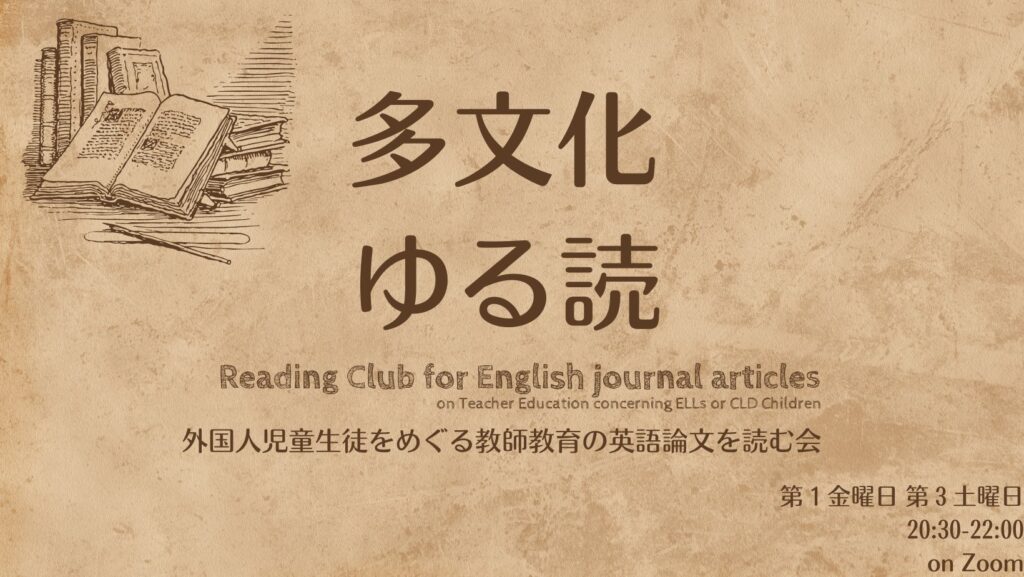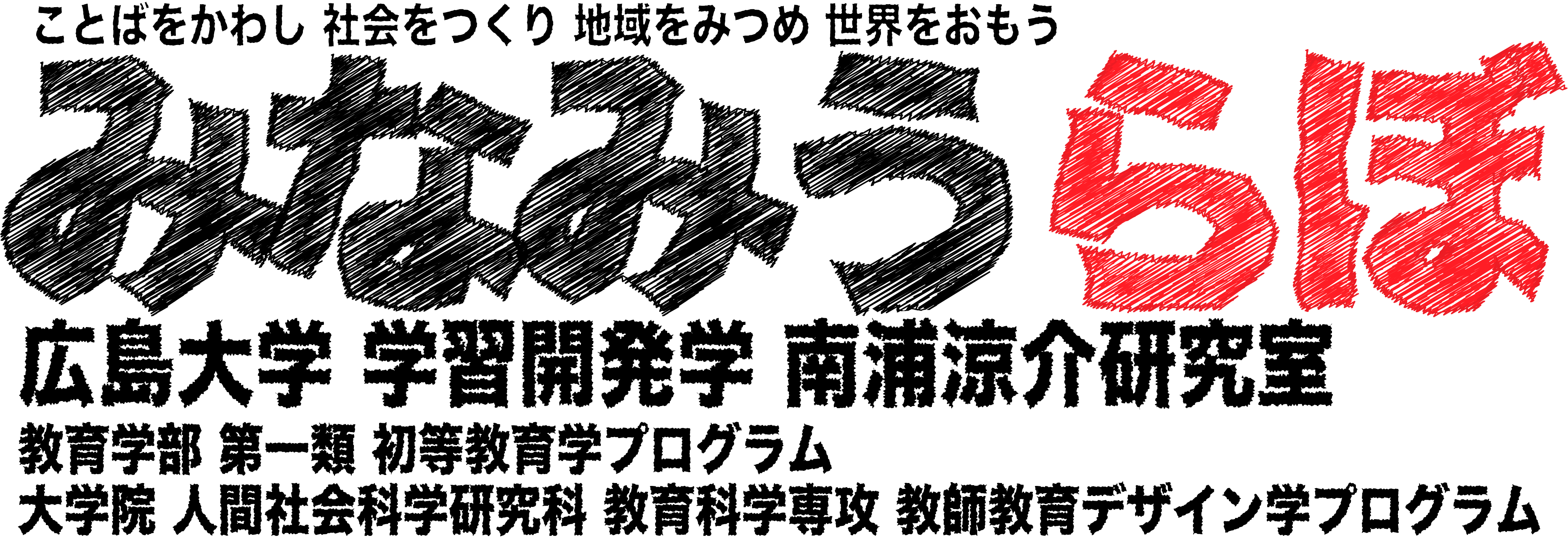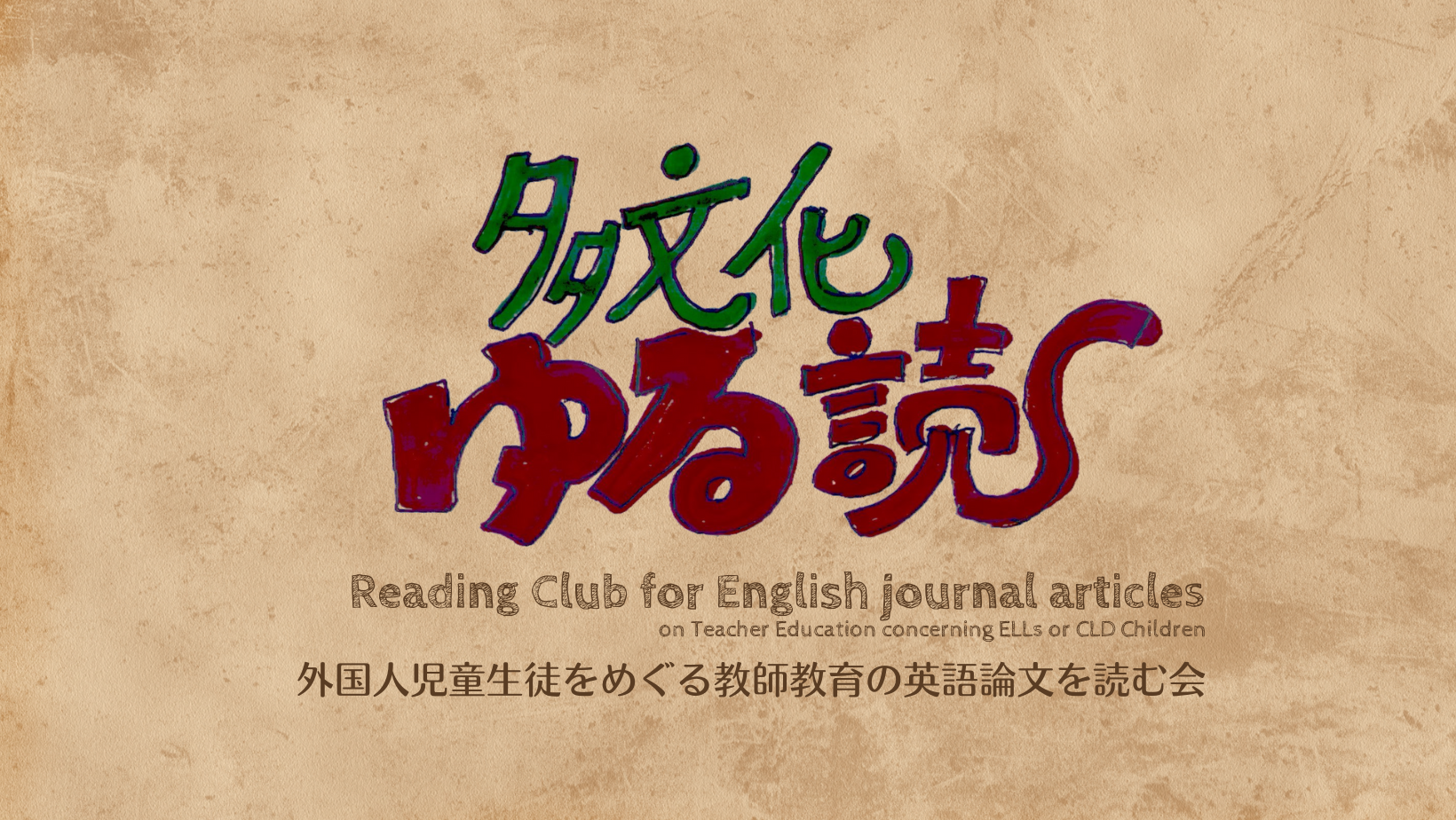外国人児童生徒をめぐる教師教育の英語論文を読む会
「多文化ゆる読」という名前で、外国人児童生徒をめぐる教師教育の英語論文を読む会をしています。
この分野は国際的な課題であるのですが日本では特定のもの以外あまり海外文献の参照が少なく,「外国人児童生徒×教師教育」に焦点を当てた英語論文の読書会です。
日時 第1金曜日・第3土曜日 20:30-22:00
参加希望の方は南浦までご連絡ください(DMでもメールアドレスでも)。グループのdiscordへご案内します
基本的な流れ
*連続参加前提ではなく、Discordに入って関心がある、参加できる、ときに参加する非連続的参加読書会です。 退会も再入会も自由です。
*ただし,マイノリティのことについて考えをやり取りするなどがありますので,できるだけ「顔の見える関係」でやっておりますので,ご参加されるときは最初に「自己紹介」チャンネルに自己紹介をいただき,登録のお名前もご自身のお名前でご登録ください
*ご参加されて7日以内に上の自己紹介がない・お名前がわからない場合は,ひとまず削除をさせていただきます(手違いややはりご参加されたい場合は改めてご連絡ください)
*翻訳機のご利用はご自由にドーゾ
これまでの文献
Schall-Leckrone, L., and McQuillan, P. J. (2012). “Preparing History teachers to Work with english Learners through a Focus on the academic Language of Historical analysis.” Journal of English for Academic Purposes 11 (3):246–266.
Abstract
This article reports empirical evidence about the influence of embedding language-based strategies into a history methods course to prepare novice history teachers to teach English learners (ELs). Mixed methods were used in an action research cycle to analyze partici- pants’ attitudes and preparedness to teach ELs history before and after being exposed to strategies for teaching the academic language of historical analysis. Data sources included surveys, interviews, observations, and student work. Findings suggest participants recognized a specialized language of history and their role as teachers of the language of history. Modifications to the infusion that increased language-based and literacy-focused activities seemed to contribute to an increased sense of preparedness for the second cohort. Participants found using language analysis to ’do history’ helpful, but few could articulate how to utilize specific strategies. One implication is the language of history needs to be made visible to history teachers before they can teach language demands of history. A second implication is infusing language-based strategies in content methods classes is one component of a comprehensive approach to preparing teachers to teach ELs. Further research is recommended to follow participants into early teaching experiences, provide site-based coaching, observe transfer of teaching skills, and assess pupil learning.
この記事では、英語学習者(ELs)に教えるための準備として、歴史教授法コースに言語ベースの戦略を組み込むことの影響に関する実証的証拠を報告する。歴史分析の学術的言語を教えるための戦略に触れる前と後の、英語学習者に歴史を教えることに対する参加者の態度と準備態勢を分析するために、混合研究法がアクションリサーチサイクルで用いられた。データソースには、調査、インタビュー、観察、および生徒の作品が含まれた。調査の結果、参加者は歴史の専門用語を認識し、歴史の言語を教える教師としての役割を認識していたことが示唆された。言語ベースでリテラシーに焦点を当てた活動を増加させるためのモディフィケーションは、2番目のグループの教師の準備感の向上に貢献したようである。参加者は、言語分析を「歴史を教える」ために使用することは有益であると感じていたが、具体的な戦略をどのように活用するか明確に説明できる者はほとんどいなかった。1つ目の示唆は、歴史の教師が歴史で求められる言語を教える前に、歴史の言語を可視化する必要があるということである。2つ目の示唆は、内容方法学のクラスに言語ベースの戦略を導入することが、ELを教える教師を育成するための包括的なアプローチの1つの要素であるということである。参加者の初期の指導経験を追跡し、現場での指導を行い、指導スキルの移転を観察し、生徒の学習を評価するためのさらなる研究が推奨される。
Ladson-Billings, G. (2014). Culturally relevant pedagogy 2.0: A.k.a. the remix. Harvard Educational Review, 84(1), 74–84.
Abstract
In this article, Ladson-Billings reflects on the history of her theory of culturally relevant pedagogy and the ways it has been used and misused since its inception. She argues for the importance of dynamic scholarship and suggests that it is time for a “remix” of her original theory: culturally sustaining pedagogy, as proposed by Paris (2012). Ladson-Billings discusses her work with the hip-hop and spoken word program First Wave as an example of how culturally sustaining pedagogy allows for a fluid understanding of culture, and a teaching practice that explicitly engages questions of equity and justice. Influenced by her experience with the First Wave program, Ladson-Billings welcomes the burgeoning literature on culturally sustaining pedagogy as a way to push forward her original goals of engaging critically in the cultural landscapes of classrooms and teacher education programs.
本稿では、Ladson-Billings自身の理論である「Culturally relevant pedagogy」の歴史と、その創始以来、それがどのように使われ、誤用されてきたかを振り返る。彼女はダイナミックな学問の重要性を主張し、Paris (2012)が提唱したように、オリジナル理論の「リミックス」、つまり文化的に持続可能な教育法の必要性を示唆している。Ladson-Billingsは、文化的に持続可能な教育学がいかに文化を流動的に理解し、公正と正義の問題に明確に関わる教育実践を可能にするかの一例として、ヒップホップとスポークンワードのプログラム「ファースト・ウェーブ」での自身の活動について論じている。Ladson-Billingsは、ファースト・ウェーブ・プログラムでの経験に影響され、教室や教師教育プログラムの文化的景観に批判的に関与するという当初の目標を推進する方法として、文化的に持続可能な教育法に関する急成長する文献を歓迎している。
Accurso, K. and Gebhard, M. (2021). SFL praxis in U.S. teacher education: A critical literature review. Language and Education, 35(5), pp.402-428.Ladson-Billings, G. (2014). Culturally relevant pedagogy 2.0: A.k.a. the remix. Harvard Educational Review, 84(1), 74–84
Abstract
This literature review analyzes the influences of systemic functional linguistics (SFL) in U.S. teacher education from 2000 to 2019. First, we describe how SFL has been contextualized in United States in response to changing demographics, new technologies, policies, and the impacts of globalization. Second, we outline our methodology, which yielded 136 publications from the fields of literacy research, teacher education, and applied linguistics. Third, we present four findings: (1) the main vehicles for introducing U.S. teachers to SFL theory and practice are grant-funded university-school partnerships, courses in colleges of education, and self-contained professional development workshops; (2) most interventions focused on introducing teachers to functional metalanguage and text analysis, with fewer focusing on multimodality; (3) SFL interventions positively influenced teachers’ level of semiotic awareness and ability to design focused disciplinary literacy instruction. Teachers’ critical awareness and confidence for literacy instruction were influenced to a lesser extent; and (4) more sustained investments in teacher professional development led to greater gains in teacher learning as well as a critical awareness of the relationship between disciplinary literacy practices and ideologies at work in K-12 schools. Based on these findings, we conclude with three recommendations for the future of critical SFL praxis in teacher education.
この文献レビューは、2000年から2019年までの米国の教師教育における選択的体系機能言語学(SFL)の影響を分析するものである。まず、人口構造の変化、新技術、政策、グローバリゼーションの影響に対応して、SFLが米国でどのように文脈化されてきたかを説明する。第二に、リテラシー研究、教師教育、応用言語学のフィールドから136の出版物を得た方法論を概説する。(3)SFLの介入は、教師の記号論的認識のレベルや、分野別のリテラシー指導を設計する能力にプラスの影響を与えた。読み書きの指導に対する教師の批判的意識と自信は、それほど影響されなかった。(4)教師の専門能力開発へのより持続的な投資は、教師の学習におけるより大きな利益だけでなく、幼稚園から高等学校までの学校で働く分野別リテラシーの実践とイデオロギーの間の関係に対する批判的意識につながった。これらの知見に基づき、教師教育における批判的SFLプラクシスの将来への3つの提言をもって結論とする。
Skelley, L., Stevens, L., and Bailey-Tarbett, K.(2022) Culturally Responsive Teaching in an Afterschool Literacy Program: Tutor Implementation and Experiences. School Community Journal, v32 n1 pp.63-84
How do educators meet the needs of our growing diverse K-12 population? Many use culturally responsive strategies in meaningful ways to ensure all students’ cultures are acknowledged, celebrated, and considered (Gay, 2010, 2013; Ladson-Billings, 1994). Although a number of culturally responsive strategies are available, it is well documented that additional research is needed to understand their impact (Ladson-Billings, 1999; Sleeter, 2012) and specific to this study, their implementation in afterschool settings (Simpkins et al., 2017). Grounded in sociocultural and critical multiculturalism theories, the purpose of this second-year case study was to examine tutors’ use of culturally responsive strategies during an elementary afterschool literacy program and was guided by these questions: (a) How did tutors implement culturally responsive strategies during tutoring sessions? (b) How did tutors experience culturally responsive strategies? This study suggests three variables affected tutors’ implementation and experiences with culturally responsive pedagogy: proficiency, curriculum, and environment. The discussion considers three questions stemming from the study’s findings and focuses on difficulties in implementing culturally responsive pedagogy, training tutors for effective use of culturally responsive pedagogy, and structuring lessons for a global perspective.
多様化する幼稚園から高等学校までの子どもたちのニーズに、教育者はどのように応えているのだろうか。すべての子どもたちの文化が認められ、祝福され、考慮されるよう、多くの教育者は文化的対応戦略を有意義な方法で用いている(Gay, 2010, 2013; Ladson-Billings, 1994)。多くの文化対応戦略が利用可能であるが、その影響(Ladson-Billings, 1999; Sleeter, 2012)を理解するためにさらなる研究が必要であることはよく知られている。社会文化理論と批判的多文化主義理論に基づいたこの2年目のケーススタディの目的は、小学校のアフタースクールの読み書きプログラムにおけるチューターの文化対応戦略の使用を調べることであり、以下の質問に導かれた。(b)チューターは文化対応戦略をどのように経験したか?(b)チューターは文化対応戦略をどのように経験したのか?この研究は、3つの変数がチューターの文化対応教育法の実施と経験に影響を与えたことを示唆している。考察では、研究結果から派生した3つの疑問について考察し、文化対応型教育法を実施する際の困難さ、文化対応型教育法を効果的に使用するためのチューターの訓練、グローバルな視点を取り入れた授業の構成に焦点を当てる。
Hollie, S. (2017). Culturally and Linguistically Responsive Teaching and Learning – Classroom Practices for Student Success, Grades K-12 (2nd Edition). Shell Education. Ch.2 “The pedagogy of culturally and linguistically responsive teachers.
This chapter is your invitation to dive into the CLR pool and start swimming so that you can be responsive to your students.
Ultimately, CLR is a challenge to your existing pedagogy. Becoming culturally responsive means that your instruction changes for the better. I call this change in instruction transformative instructional practices or TIPs. CLR can renovate or overhaul your instruction, depending on where you are in your teaching and where you want to be at the end of the day. CLR is rooted in seeing and feeling the change for yourself, no different from losing weight, getting a new hairstyle, or buying a new outfit. In other words, you can see the Hollie, Sharroky. Culturally and Linguistically Responsive Teaching and Learning (Second Edition) : Classroom Practices for Student Success, Shell Educational difference without any external endorsement or research because you know that it feels right. This, however, is not to say that there is not ample research support for the effectiveness of these practices.
In fact, the number of researchers providing supportive evidence is overwhelming (Dolan et al. 1993; Goodwin 2011; Johnson and Johnson 1987; Slavin 2010; Tate 2010; Zeichner 2003). Regardless, the most important evidence is seen within your students as they become more engaged and invested in their learning. The question is, are you willing to be transformed? Are you willing to participate in the journey to responsiveness?
Cardozo-Gaibisso, L., Allexsaht-Snider, M., Buxton, C.A. (2017). Curriculum in Motion for English Language Learners in Science: Teachers Supporting Newcomer Unaccompanied Youth. In: de Oliveira, L., Campbell Wilcox, K. (eds) Teaching Science to English Language Learners. Palgrave Macmillan, Cham.
This chapter aims at providing a dynamic pedagogical and instructional framework incorporating classroom practices for serving newcomer unaccompanied youth. This framework is the result of a collaborative approach among teacher educators, a science teacher, and students in a project called Curriculum in Motion (CiM). The CiM project conceptualized curriculum as an in-progress design, making it suitable for other science teachers to adapt it in their particular contexts. We conceptualize language as a dynamic resource for science meaning making. We provide an overview of the perspectives that informed our work as we developed the CiM project, and an outline of the principles that framed our teaching in the science classroom, as well as relevant examples of student work.
本章の目的は、新参の同伴者のいない青少年に対応するための授業実践を組み込んだ、ダイナミックな教育学的・指導的枠組みを提供することである。この枠組みは、Curriculum in Motion(CiM)と呼ばれるプロジェクトにおける、教師教育者、科学教師、学生たちの共同アプローチの結果である。CiMプロジェクトでは、カリキュラムを進行中のデザインとして概念化し、他の科学教師がそれぞれの文脈でアダプテーションできるようにした。我々は、言語を科学の意味づけのためのダイナミックなリソースとして概念化している。CiMプロジェクトを開発する際に、私たちの仕事に反映された視点の概要と、科学教室での私たちの教育実習の枠組みとなった原則の概要、そして関連する生徒の作品例を紹介する。
Hollie, S. (2012). Culturally and Linguistically Responsive Teaching and Learning – Classroom Practices for Student Success, Grades K-12 (1st Edition). Shell Education. Ch.2 “The pedagogy of culturally and linguistically responsive teachers. ※のChapter 2の部分(pp.43-60)
The relevance of this book for educators is its focus on two aspects of culturally and linguistically responsive and relevant instruction.
The first aspect is the focus on equity and diversity, which are addressed in the first two chapters. Chapters 1 and 2 specifically center on the sensitive issues of race, culture, and language by providing the reader with a laser focus on the complexity of culture and a variant perspective on language difference. The second aspect of the book concentrates on pedagogy, based on the premise that having discussions about teaching is just not sufficient to address the problems of underserved students. In order to be culturally responsive, transforming instructional practices must oceur. Not only must educators think differently, but they must teach differently as well. Concrete activities and strategies are rolled out through five areas described fully in Chapters 3 though 7. The areas are classroom management, academic—literacy instruction, academic—vocabulary instruction, academic—language instruction, and creating a responsive learning environment. Based on my research, these are the areas that teachers and students are most in need of and represent the greatest possibility for change. (序章p.13)
本書が教育者にとって有益なのは、文化的言語的にやさしい適切な指導の2つの側面に焦点を当てていることである。
第一の側面は、公平性と多様性に焦点を当てていることであり、これは最初の2章で扱われている。第1章と第2章では、特に人種、文化、言語というデリケートな問題に焦点を当て、文化の複雑さと言語の違いに対する多様な視点を読者に提供している。本書の第二の側面は、十分な教育を受けていない生徒の問題に対処するためには、教育について議論するだけでは不十分であるという前提に基づいて、教育法に集中している。文化的に対応するためには、指導法を変革しなければならない。教育者はこれまでとは違う考え方をするだけでなく、これまでとは違う教え方をしなければならない。具体的な活動や戦略は、第3章から第7章に詳述されている5つの分野を通して展開される。その分野とは、学級経営、読み書きの指導、学問的語彙の指導、学問的言語の指導、反応のよい学習環境の構築である。私の調査によると、これらの分野は教員と養成課程の学生たちが最も必要としている分野であり、変革の可能性が最も高い分野である。
Lucas, T., de Oliveira, L. C. & Villegas, A. M. (2014). Preparing Linguistically Responsive Teachers in Multilingual Contexts, Springer Science and Business Media B.V, p. 219-230. (Multilingual Education; vol. 10)
It takes teachers many years to develop expertise in the complex set of knowledge, skills, and orientations needed to teach culturally and linguistically diverse (CLD) students well. The process begins in preservice preparation and continues into the early years of teaching and throughout a teacher’s career. This article examines preservice teacher education as the first phase in the continuum of teacher development for teaching ELLs. Drawing on our framework of orientations and pedagogical knowledge and skills for preparing linguistically responsive teachers (Lucas & Villegas, 2011; Lucas, Villegas, & Freedson-Gonzalez, 2008), we show how Feiman-Nemser’s (2001) framework of central tasks for learning to teach can serve as a guide for identifying tasks for learning to teach CLD students and for guiding the construction of a coherent approach to preparing teachers of CLD students that begins in preservice programs, laying the foundation for continued development throughout the teaching career.
教員養成課程の学生たちが、文化的・言語的に多様な(CLD)学生たちを上手に教えるために必要な複雑な知識、技能、方向性を身につけるには、長い年月がかかる。その過程は、現職教員になる前の準備段階から始まり、教職に就いて間もない時期、そして教師のキャリア全体を通して続く。この論文では、ELLを教えるための教師教育の第一段階として、現職教師教育について考察する。言語学的に対応できる教員を養成するための方向性と教育学的知識・技能の枠組み(Lucas & Villegas, 2011; Lucas, Villegas, & Freedson-Gonzalez, 2008)を用いて、Feiman-Nemser(2001)の「教えることを学ぶための中心的課題」の枠組みが、CLDの学生を教えるための課題を特定するための指針として、また、教員養成課程の学生たちから始まり、教員としてのキャリアを通して継続的に発展するための基礎を築く、CLDの学生を教える教員を養成するための首尾一貫したアプローチを構築するための指針として、どのように役立つかを示す。
Min, M., Whitehead, A., Wells, C., & Akerson V. (2023). Unpacking elementary preservice teachers’ beliefs on culturally and linguistically responsive mathematics and science teaching for English language learners.
With an increasing number of English Language Learners (ELLs), the landscape of public schools in the United States has been rapidly changing. However, ELLs’ academic performance is consistently lower than their native English-speaking peers’ and many in-service teachers feel ill-prepared to teach ELLs in a culturally and linguistically responsive way. This is especially true for mainstream teachers who teach STEM-related subjects. This study explores how pre-service elementary school teachers perceive culturally and linguistically responsive mathematics and science teaching practices for ELLs. A qualitative research design with interviews and constant comparative analysis was employed. Pre-service teachers’ lively voices that unpack their beliefs on the characteristics of culturally and linguistically responsive math and science teaching are illustrated around teachers’ scaffolding strategies, ELLs’ learning experiences, and environments. Suggestions for teacher educators, education scholars, and practitioners are provided to advance the discourse of how to better prepare teachers to teach mathematics and science to ELLs.
英語学習者(ELL)の増加に伴い、米国の公立学校を取り巻く環境は急速に変化している。しかし、ELL の学業成績は、英語を母国語とする生徒に比べ一貫して低く、多くの現職教師は、ELL を文化的・言語的に対応した方法で教える準備ができていないと感じている。これは特に、STEM関連科目を教えるメインストリームの教師に当てはまる。本研究では、教員養成段階の学生が、ELLのために文化的および言語的に対応した数学および科学の教育実践をどのように認識しているかを探る。インタビューと定比較分析を用いた質的研究デザインを採用した。文化的・言語的に対応した算数・理科教育の特徴に関する信念を解き明かす教員養成段階の学生たちの生き生きとした声が、教員の足場作り戦略、ELLsの学習経験、環境を中心に示されている。教師教育者、教育学者、実践家への提言は、ELLに数学と科学を教える教師をよりよく準備する方法についての言説を前進させるために提供される。
Coady, M. R., Harper, C., and de Jong, E. (2015). Aiming for Equity: Preparing Mainstream Teachers for Inclusion or Inclusive Classrooms?. TESOL Quarterly, 50(2), pp.340-368.
世界中のメインストリームの教師たちは、第二言語としての英語学習者(ELL)を含め、多様な学習ニーズを持つ小学生の指導に差をつけることをますます求められている。教師養成課程は、子どもたちの対象言語としての英語の力を伸ばす実践につながっているのだろうか。また、教員養成課程を修了した学生たちは,その後ELLのために、教室でどのような指導を行っているのだろうか。この研究は第二言語の教育についての教員養成課程を卒業した2人の教師のビリーフと実践を調べたものである。その結果、ELLが少ない初等教育学級でELLを指導する教員養成課程を卒業した若手教師たちは、一般的なアコモデーションの戦略や即応的なスキャフォールディングの技法を用いてはいたが、ELLの言語発達を促進するための具体的な実践を行うことはほとんど見られなかった。著者らは、ここから第二言語教育の教師教育者への示唆について論じている。
Lucas, T., Strom, K., Bratkovich, M. & Wnuk, J. (2018). Inservice Preparation for Mainstream Teachers of English Language Learners: A Review of the Empirical Literature, Educational Forum. 82 (2), 156-173
メインストリームのELL教師たちのための現職研修の性質と目標に関する実証的な文献によると、現職研修は教師の教育学的知識とスキルの向上に重点を置いているが、同時に、教員養成課程の学生たちや学校の状況について学んだり、自分たちの実践について探求したり、ELLを教えるための教科知識を深めたり、信念を分析し変化させたり、ELL教師としてのアイデンティティを育んだりすることも重要視されている。
Mickan, P. (2022). Systemic Functional Linguistic Perspectives in TESOL: Curriculum Design and Text-Based Instruction,TESOL in Context, 31 (1), 7-24
本稿では、TESOLカリキュラムにおけるハリデー(1994, 2014)の選択的体系機能言語学の一般的影響について概説する。社会的記号論としての言語と、意味の学習としての言語学習に関するハリデーの説明は、ジャンルやテキストに基づく教育において国際的に応用されている。選択的体系機能言語学における音域の概念は、異なる意味を表現するためのテキストの言語的変化を説明するものである。SFLの研究では、機能や社会的文脈と結びついたテキストタイプの語彙的構築について、教師が明示的に指導していることが記録されている。このような明示的な指導は、様々なテキストタイプにおける意味形成のための生徒の意思決定に役立っている。教師教育におけるSFLの適用についても言及されている。SFLとオーストラリアの教育における読み書き能力の基準との関連性についても言及されている。
こんな人で読んでいます
(名前を出してもいいですよの方。他にもいます。あいうえお順)
- 石田喜美(横浜国立大学)
子ども・若者の学校外での学びをいかに学校内での学びと結びつけるかという視点から、さまざまなアプローチで、言葉や読書の教育に関わる研究・実践を行っています。最近は、ゲームと教育・学習とを結びつけた活動に興味があります。「図書館たほいや」普及委員会のメンバー(風紀委員)です。 - 小栁亜季(千里金蘭大学)
イギリス(主にイングランド)の言語教育実践を研究しています。異なる言語的背景を持つ生徒に、どのような言語教育のカリキュラムが求められるかを主な研究課題として研究しています。メインストリームとされる教育と外国人児童生徒への教育の間のつながりをどのように構築していくかにも興味があります。 - 権野さち(お茶の水女子大学大学院)
すべての子ども・若者が出自(生まれ育ち・国籍)、性別、宗教等に関わらず、公正な教育を受ける機会が平等に得られることを願って研究をしています。日本の学校に通う外国につながる(CLD)高校生の教育的指導・支援に興味があります。 - 田野茜〈あもすん。〉(京都大学大学院)
「他人と一緒に学ぶことの意義」を考えながら、「教室内すべての人が自分らしくいられる教育」について考えています。神戸出身で幼少期から身近な存在だった外国につながる子ども(CLD児童生徒)の教育にも継続して興味を持っています。 - 南浦涼介(広島大学・管理人)
外国人児童生徒を包摂するカリキュラムから評価までを教師教育との関係で考えるのに興味があります


